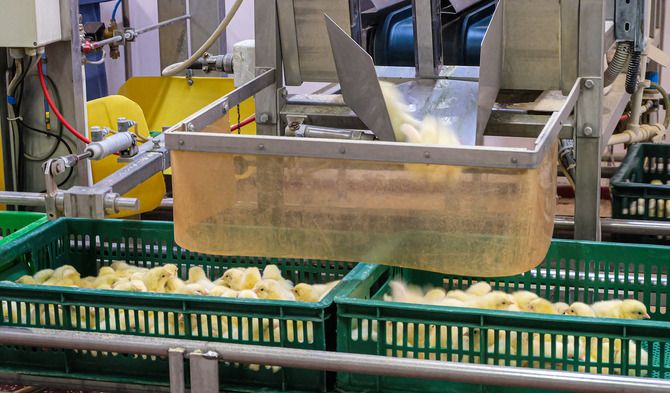Organizers of the $6 million Egg-Tech Prize—a high-profile global competition to find scalable technologies to sex chicks before they hatch—have not yet issued a final award because “none of the applicants met the criteria,” AFN has learned.
While the egg industry has been trying to end the practice for years, many consumers remain blissfully unaware that it slaughters billions of male chicks every year… but not to put meat on the table, note the organizers of the Egg-Tech Prize, the Foundation for Food & Agriculture Research (FFAR) and Open Philanthropy.
Right now, hatcheries incubate billions of eggs, wait 21 days for them to hatch, hire trained ‘sexers’ to determine their sex, and then cull 50% of their chicks (via suffocation or grinding) because the males are of no use to the food industry. They can’t lay eggs, and there’s no market for their meat, as the breeds of chicken used in the egg and meat industries are different.
Ethics aside, this is bad for business and the environment, notes FFAR. “If hatcheries had technology that determined the egg’s sex on the day it is laid, over 6 billion male eggs could be used for food, animal feed or vaccine production.
“This could vastly reduce the cost and carbon footprint of incubating layer eggs, while freeing up space for the incubation of female eggs, increasing the efficiency of production. Estimates suggest preventing male chick culling would save industry approximately $500 million from wasted eggs and labor.”
‘It was its unanimous opinion that none of the applicants met the criteria to merit the award of the prize’
So what advances do in-ovo sexing startups vying to win the Egg-Tech Prize need to make to show they have “a scalable, commercially viable solution to male chick culling worldwide?”
According to Dr Jeffrey L. Rosichan, director, Crops of the Future Collaborative at FFAR, none of the applicants to the competition have yet been able to meet all the criteria, which address factors such as speed, accuracy, economic feasibility, and throughput.
He told AFN: “The prize committee met with each of the contestants in the fall of 2022 [following the August 2022 deadline for phase II of the competition].
“The committee was excited and encouraged to see the progress each of the contestants had achieved. However, at that time, it was its unanimous opinion that none of the applicants met the criteria to merit the award of the prize.”
He added: “The committee recommended extending the deadline to allow applicants additional time to further develop their solution to meet the criteria. It also provided each applicant with specific targets it would need to see achieved by the end of the extension period to merit an award.”

In-ovo sexing gaining ground in Europe while US watches and waits
That said, in-ovo sexing is gaining traction in Europe, spurred by animal welfare legislation. Germany and France (with some exceptions) have already banned the practice of culling male chicks; Italy plans to phase it out by 2026; and Switzerland now requires more humane culling methods.
Animal welfare groups are also pushing the European Commission to include an EU-wide phase-out of male chick culling in its revision of EU animal welfare legislation.
US producers, however, who are not under the same pressure from government to end the practice, have been slower to engage. United Egg Producers (UEP), which accounts for 90% of US egg production, called for the elimination of day-old male chick culling in 2016 but issued a statement five years later arguing that “a method that meets the food safety, ethical standards and scalable solutions needed for the United States is not yet available.”
In an email to AFN this week asking if its view had changed, a spokesperson said: “The UEP statement is still accurate as it stands.”
‘Egg sexing solutions currently have around 10-20% market penetration in Europe’
But some stakeholders are much more optimistic.
Robert Yaman, founder of new nonprofit Innovate Animal Ag (IAA), estimates that “egg sexing solutions currently have around 10-20% market penetration in Europe.”
Given that tech solutions are already out there, he told AFN, “Instead of starting a new company, I felt I could have a bigger impact by taking an ecosystem approach like The Good Food Institute and New Harvest.
“We’re not favoring a particular provider or approach, we just want to make it as easy as possible for this technology, in whatever form, to come onto the market,” added Yaman, who has been engaging with stakeholders across the egg supply chain.
“The technology is actually more advanced than people realize. There are already large hatcheries using it at a cost of 1-3 euro cents per table egg. But many people I’ve been talking to in the US were not aware that they can actually go to these tech companies, sign a contract and implement the technology by the end of the year.
“So part of what we’re doing is trying to bring more attention to this issue, so I’m currently fundraising and hiring roles in corporate engagement and communications. We’re also doing a consumer study about American consumer attitudes on this [male chick culling and in ovo sexing tech], as I think there will need to be a substantial education component to this.”
He added: “I think a lot of folks tend to stay away from talking about animal welfare in food marketing, but there are ways to talk about it that are inclusive and bring people in, and as long as we can ensure these technologies are affordable, I think this [ending the culling of male chicks] is really a no brainer.”
“I believe that Innovate Animal Ag can help bring this technology to the US market by the end of 2024.”
‘The cost of all of these technologies will go down over time’
He added: “I think the path to commercialization in the US starts at the high end of the market where consumers have shown they are willing to pay a price for higher quality, higher welfare organic or pasture-raised eggs.”
But is now a good time to convince egg producers to implement any kind of technology that in the short term could put up egg prices, which hit record highs late last year following an Avian flu outbreak?
“There are ways to reduce the capex burden on businesses, so maybe you can lease out or provide the equipment to hatcheries and then charge per egg,” said Yaman.
“I also think you’ll see the cost of these technologies will go down over time, to the point where there is no cost [to implementing in-ovo sexing] once you factor in the savings from freeing up incubator space and not paying people to sex the chicks. Ultimately the technology could be a cost saver.”
Sex determination techniques
Currently, in-ovo sex determination technologies can be grouped into six buckets, said Yaman, who previously worked at cultivated fat startup Mission Barns:
1)Non-Invasive Imaging (already on the market): Looking through the shell of an egg to determine the sex of the embryo inside.
Market leader AAT—which has machines in seven hatcheries—uses hyperspectral imaging to determine the color of the embryo’s feathers, which can sex eggs of brown layers, since males and females have different colored feathers.
Orbem, meanwhile, combines AI with MRI (magnetic resonance imaging), to examine the organ development of embryos to detect physical differences between the males and females without penetrating the shell, and can work with brown and white layers.
While non-invasive imaging is “fast, simple, and cheap,” said Yaman, the downside is that you must wait until a late stage in the embryo’s incubation (12 days +) to ensure accuracy.
2) Allantoic Sampling (already on the market): Extracting a drop of liquid from eggs around day nine of incubation and testing it for biomarkers that enable it to sex the egg.
This is a high-throughput approach currently commercialized in Europe through the Respeggt brand deploying technology from In Ovo, PLANTegg and Seleggt and highlighted on eggs sold in leading retailers including Carrefour, Rewe, and Edeka.
It is “generally more expensive than non-invasive imaging,” but “can work earlier on in the incubation period,” said Yaman, noting that the German Federal Agricultural Ministry recently published a study indicating that chicken embryos can’t feel pain before day 13 of incubation.
“This likely means that the German ban on chick culling will be adjusted from a day-7 ban to a day-13 ban,” he predicted. “This is important news for the startups creating in-ovo egg sexing technology, since none of the in-market solutions can sex before day 7, but many can before day 13.”
3) Genetic Editing: Using gene editing to give male embryos a genetic marker that allows them to be easily identified (eggXYt), or to stop growing entirely (Huminn). Only the males carry the genetic trait, so females and the eggs that make it into the supply are not genetically modified.
While any approach using genetic engineering can present regulatory or consumer challenges, this is exciting as it enables non-invasive, rapid sex detection before eggs enter the incubation process, whereas most other approaches are only viable several days into the incubation process, said Yaman.
According to Dr Rosichan at FFAR: “Genetic interventions/innovations may provide a future solution and may have additional factors that the industry would need to consider/resolve to be commercially viable.”
4) Volatile Analysis: Detecting sex-specific volatiles that escape through the eggshell.
5) Spectroscopic Imaging: Taking images of embryos via tiny holes in the shell. This is more complex and expensive than non-invasive imaging but can be effective at an earlier stage of incubation, said Yaman.
6) Sex reversal: Israeli firm SOOS Technology is exploring techniques including changing humidity, temperature, and sound vibrations to switch the sex of embryos from male to female, which if validated, would be an exciting solution, although the technique is still in its infancy.




